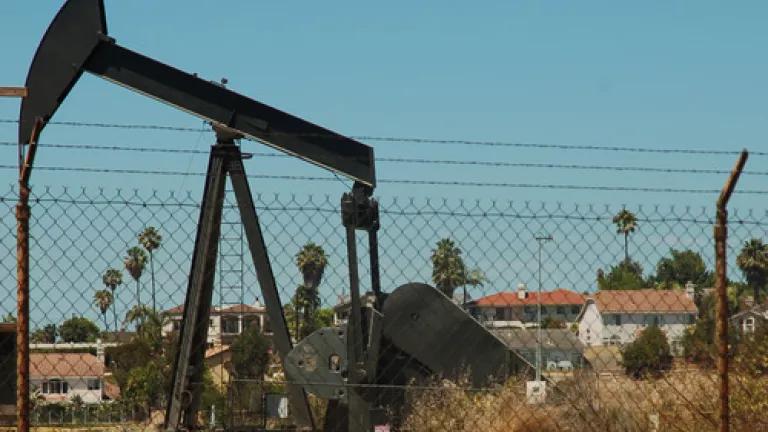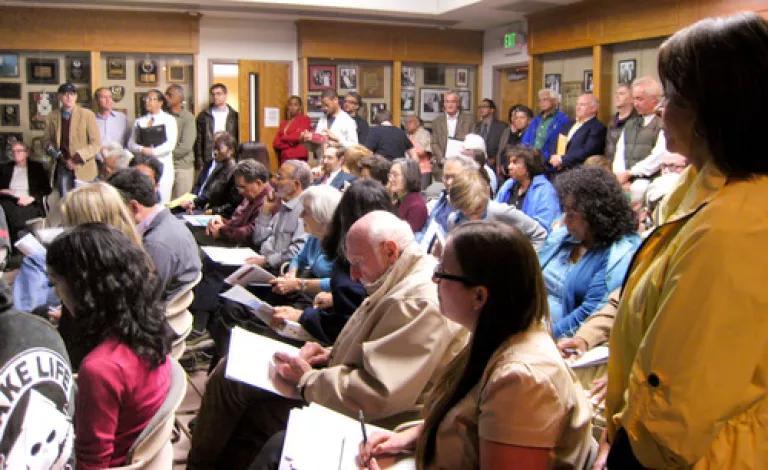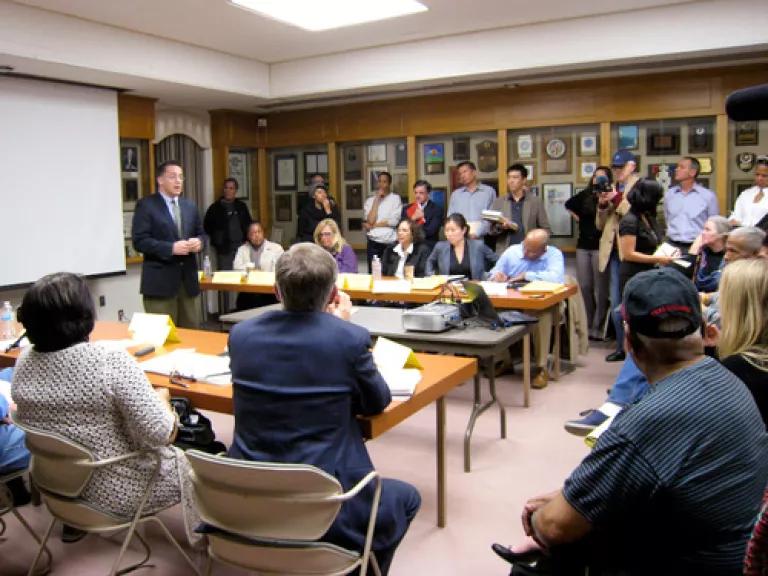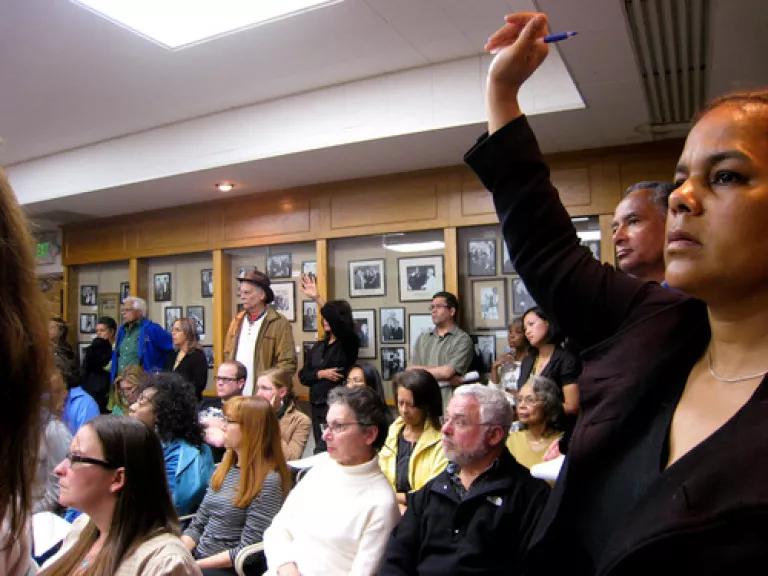
The controversial drilling practice known as fracking has made its way to southern California.
Last night, over 100 concerned citizens packed the meeting room at the Kenneth Hahn State Recreation Area Community Center to hear representatives from the County of Los Angeles, the state of California, and Plains Exploration and Production Company (PXP) talk about PXP’s plans to study the feasibility of, and the potential impacts that could result from, fracking in the Baldwin Hills.
Fracking – the pumping of large quantities of fluids into the ground at high pressure to stimulate the flow and recovery of oil and gas – is a serious and growing concern all over the country. My colleagues Kate Sinding, Briana Mordick, Amy Mall and others have worked tirelessly to protect drinking water in New York from the impacts of fracking; investigate increased seismic activity related to fracking in Ohio; push for strong new rules governing fracking at the federal level; and more.
Here in California, however, it has been difficult to get even the most basic information about fracking and its potential impacts to our communities. The term “fracking” is not defined under California law because there are no laws or regulations that deal with fracking. Nor is the state required to track oil companies’ fracking operations. As a result, the state doesn’t know exactly where or how frequently fracking is occurring, or which communities might be at risk. Our colleagues with the Environmental Working Group in Sacramento published a report on this troubling state of affairs just last week.
These are big problems, but we saw the fracking study I mentioned above as an opportunity to start uncovering some of that basic information and sharing it with the public. The study is one of several provisions that NRDC and other parties negotiated in a settlement agreement last July that resolved litigation over PXP’s expansion of oil drilling in the Baldwin Hills. (I blogged about the settlement here.) Upon learning that PXP was on the verge of selecting a consultant for the fracking study, NRDC and Community Health Councils (CHC), a health advocacy group based in Baldwin Hills and our coalition partner, sent a letter to the County and PXP in January asking for a public meeting to discuss the scope of the study and to allow members of the community to ask basic questions about fracking and its potential impacts in the Baldwin Hills. They agreed, and the meeting took place last night.

At the meeting, PXP representatives explained that the fracking study will be the first of its kind in California. They also gave brief presentations on the scope of the study, which will cover a range of topics including the potential for groundwater and surface water contamination and gas migration, the potential environmental effects of different chemicals used in fracking, the potential for induced earthquakes, and air emissions from fracking. PXP committed to posting these presentations on its Web site, and the County invited the public to submit written suggestions as to what other topics should be included in the study. Anyone who has suggestions should email them to Rena Kambara at rkambara@planning.lacounty.gov before the close of business on Thursday, March 15th. NRDC and CHC will be submitting our suggestions shortly.

Also speaking at the meeting were Jason Marshall, chief deputy director of the state’s Department of Conservation (DOC), and Tim Kustic, state Oil and Gas Supervisor for the Division of Oil, Gas and Geothermal Resources (DOGGR, a division of DOC). One of the evening's most striking statements came from Mr. Marshall, who candidly admitted that it probably was an “oversight” that representatives from DOC and DOGGR haven’t been as involved with issues in the Baldwin Hills as they could be, and committed to more frequent involvement on the part of those agencies in the future. Many of the attendees, myself included, were very glad to hear this, as there had been a sense that state regulators had been neglecting important issues at the largest urban oil field in the country. In addition, Mr. Marshall acknowledged that fracking has been occurring in California for at least the last thirty years; confirmed that DOGGR does not know where all the fracked wells are located; and admitted that there is no monitoring system in California for fracking.
Understandably, these troubling admissions – along with the sense that this was the first time many folks had heard about PXP’s fracking plans – generated both anger and frustration among those in attendance. Some folks were upset that PXP already has fracked two wells, which was required to obtain data for the fracking study, without notifying the community as a whole. Although a community advisory group known as the Community Advisory Panel (CAP) meets every month on oil field issues – in fact, this community update was held jointly with this month’s CAP meeting – some felt the CAP wasn’t achieving its intended function of taking in important information and disseminating it back to folks in the broader community. This is a critical problem that needs to be fixed.
With regard to the startling absence of any state regulation of fracking, some good news may be on the horizon. A bill currently working its way through the Legislature, Assembly Bill 591, would require oil companies to disclose important fracking-related information such as the location of each frack job and the amounts of chemicals and water used. Although AB 591 only covers the disclosure of information and not anything more substantive, it would be a start. NRDC is reviewing the bill’s language thoroughly – for example, we want to make sure that companies can’t rely on bogus trade secret claims to avoid having to disclose the composition of their fracking fluids.

As for what's next in the Baldwin Hills, once the fracking study’s scope has been completed, PXP’s consultant will have until July 2012 to complete the study itself, at which time it will be subject to independent peer review. The study’s results will be then released to the public in or around August 2012, at which time we would urge the County and PXP to hold a follow-up public meeting to discuss the results. In the meantime, anyone who would like periodic updates on this issue from our coalition, the Greater Baldwin Hills Alliance, please contact my CHC colleague Mark Glassock at MGlassock@chc-inc.org to be added to our email list. As last night’s strong turnout demonstrated, this is an extremely important issue for the communities surrounding the Baldwin Hills, and we will continue to stay involved to make sure those communities are protected.
Photo credits: NRDC

